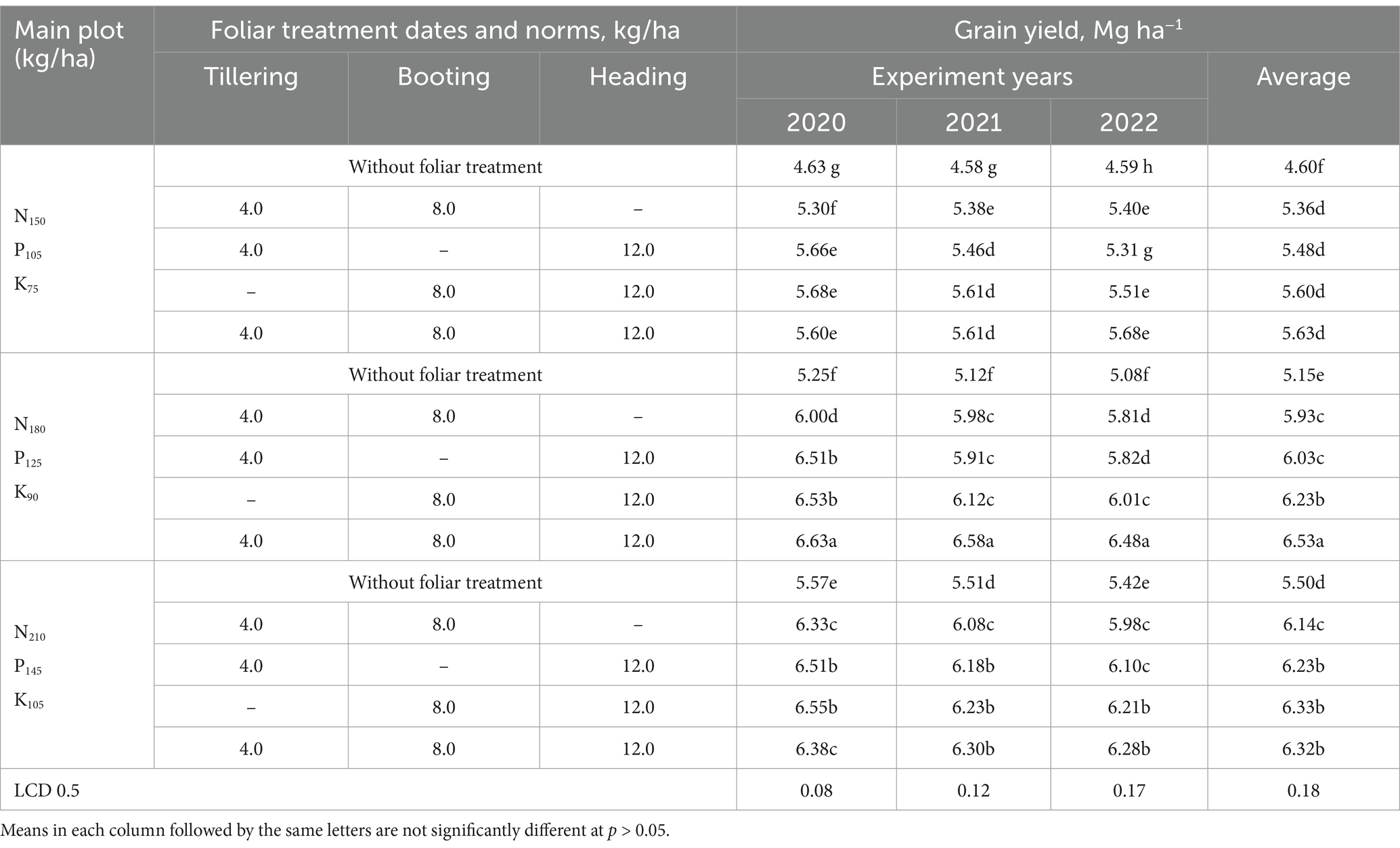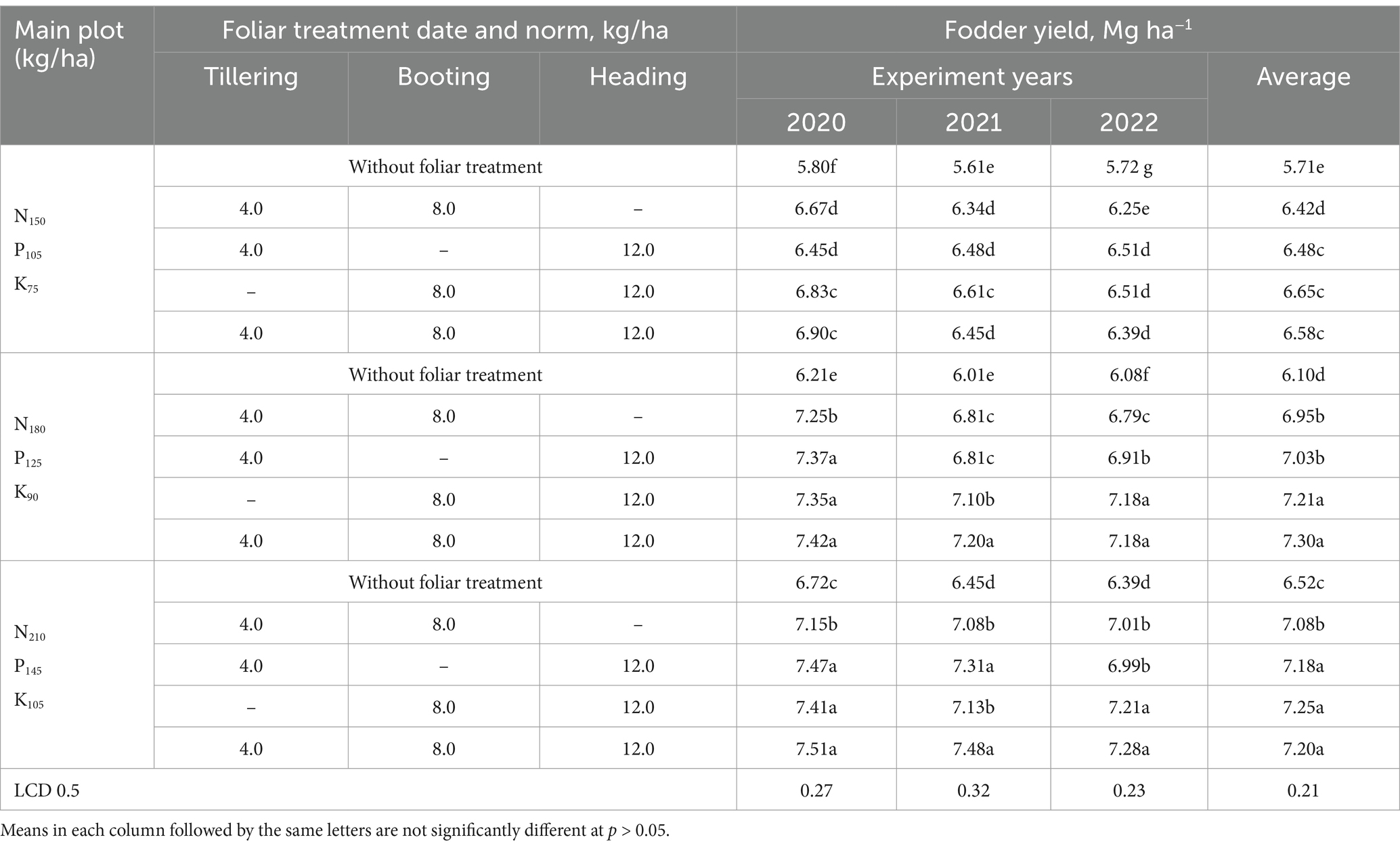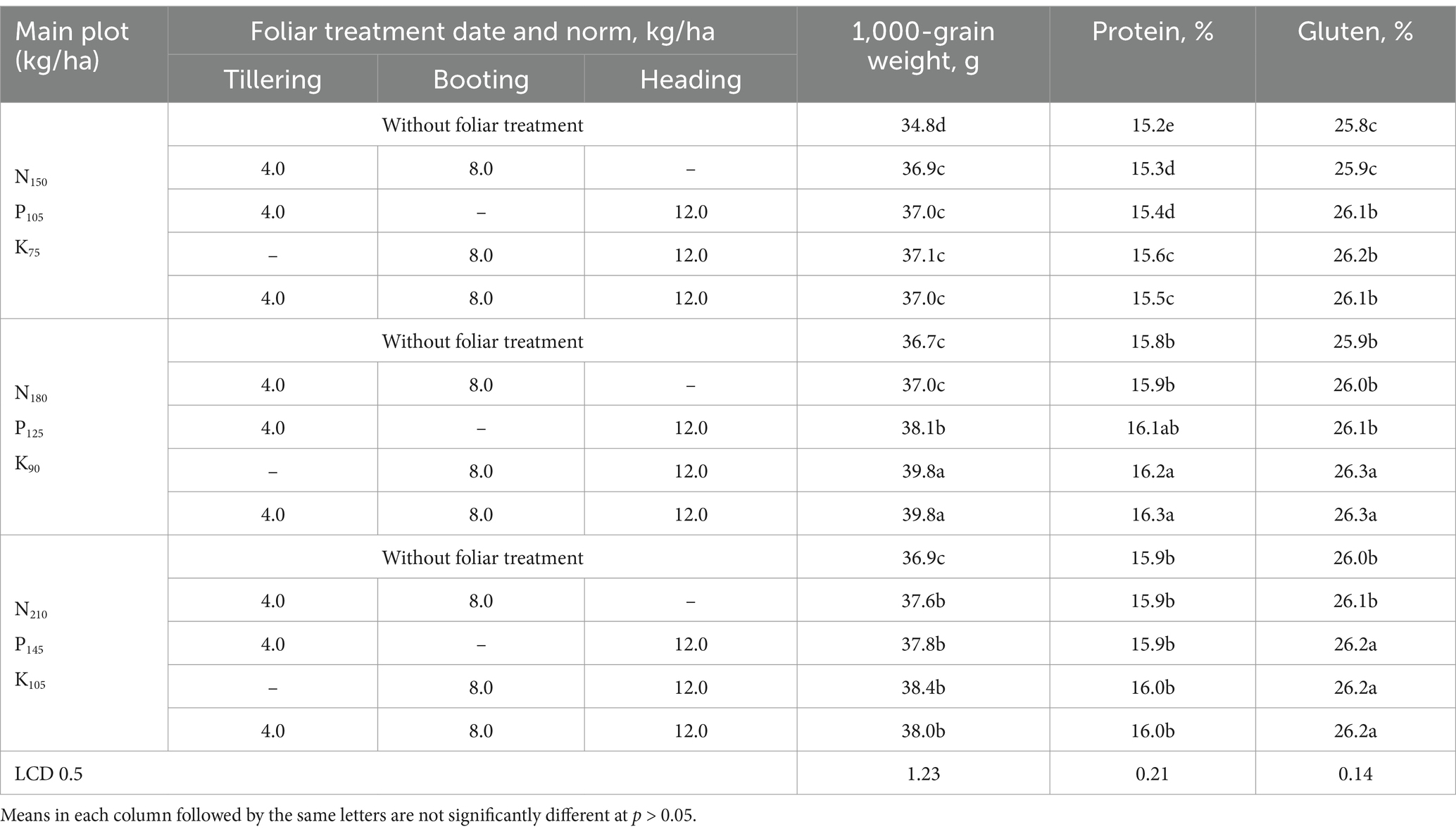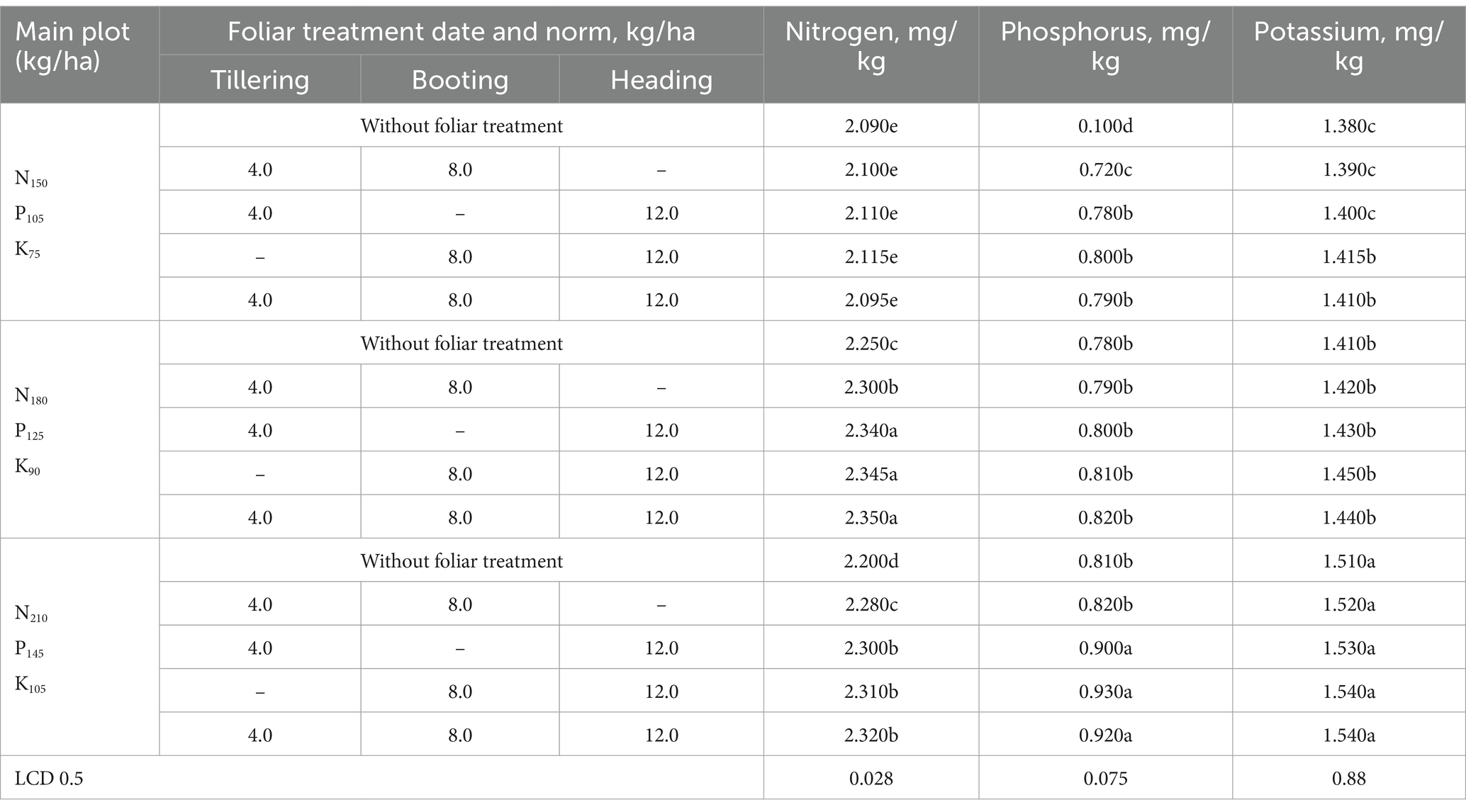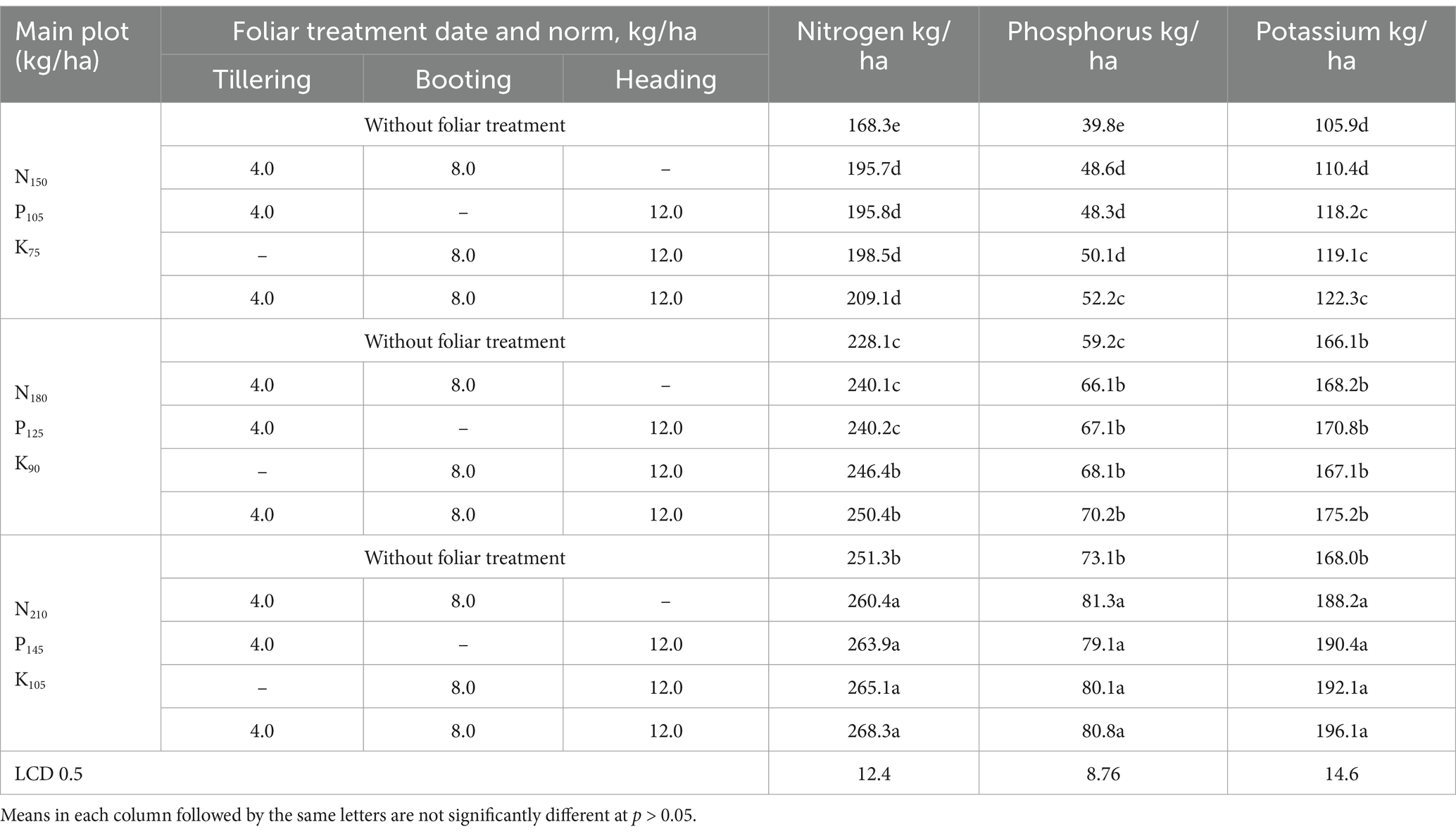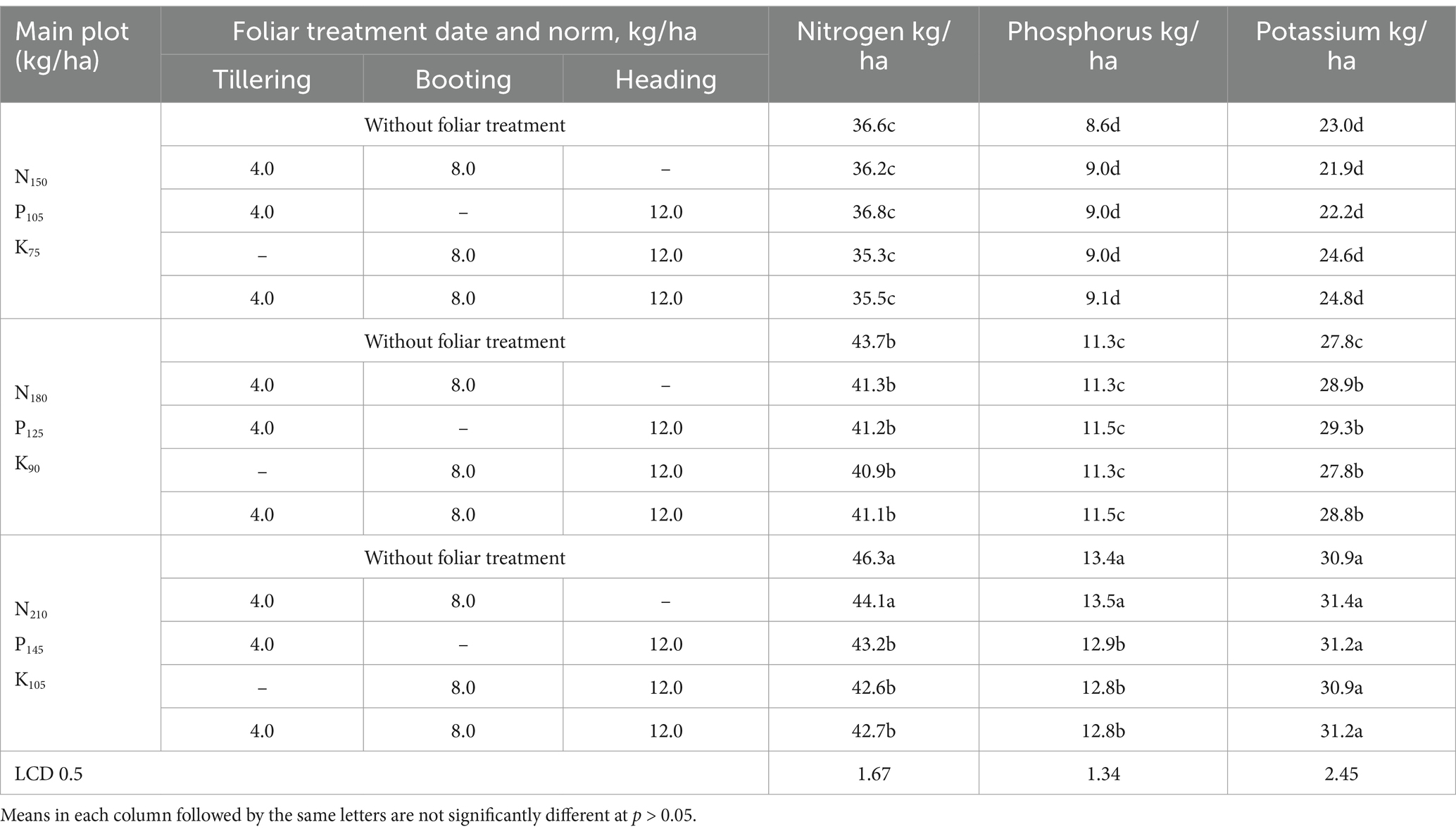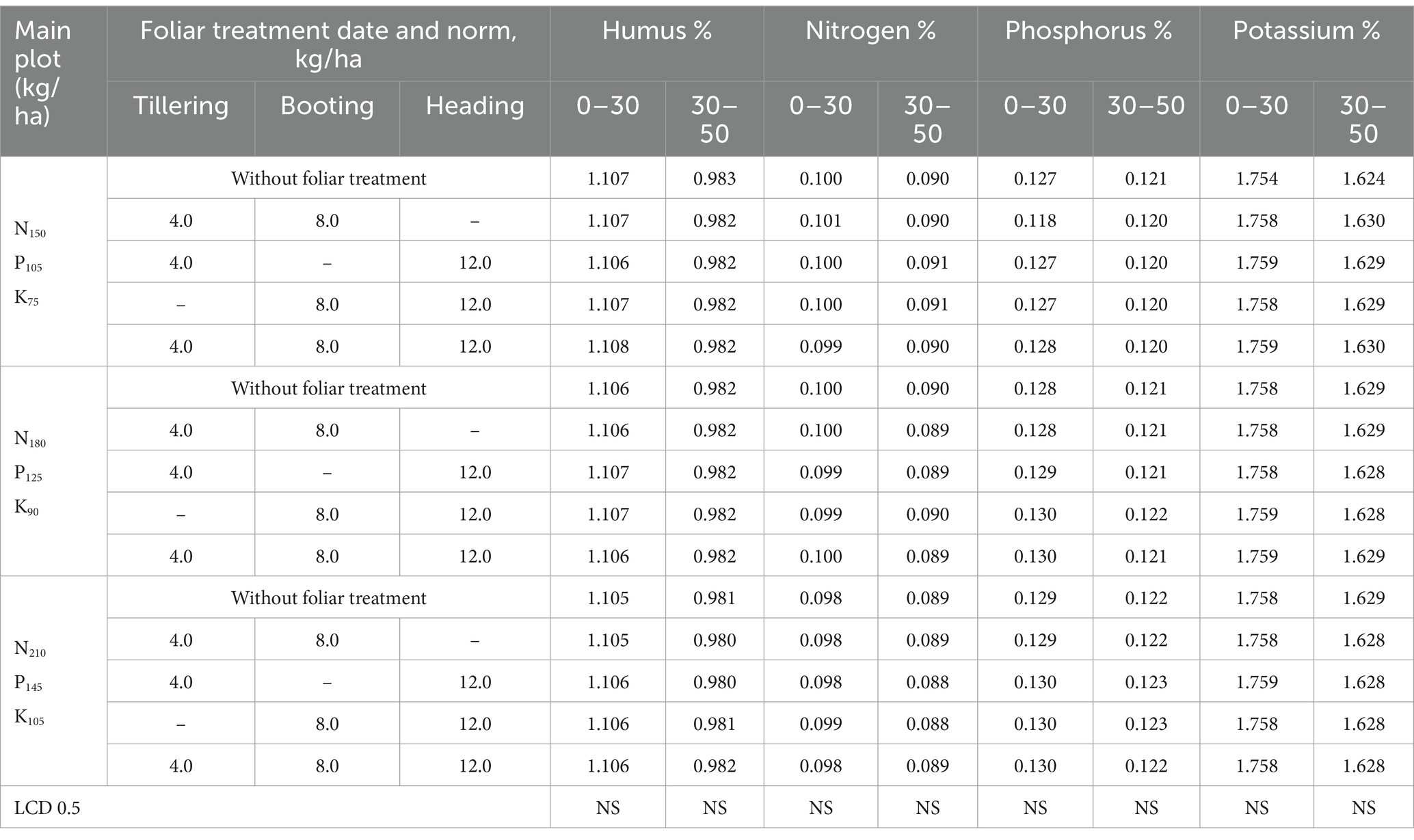- 1Tashkent State Agrarian University, Tashkent, Uzbekistan
- 2Tashkent Institute of Irrigation and Agricultural Mechanization Engineers (TIIAME) National Research University, Tashkent, Uzbekistan
- 3Institute of Agriculture and Agrotechnologies of Karakalpakstan, Nukus, Karakalpakstan
- 4Fergana State University, Fergana, Uzbekistan
- 5Karshi State University, Karshi, Uzbekistan
- 6Food and Agriculture Organization (FAO) Representative Office in Tashkent, Tashkent, Uzbekistan
The effects of chemical fertilizers on crop growth and grain yield are relatively well-known, but little is known about their synergistic effects with foliar nutrition. The factorial experiment was conducted using a strip-plot design. The main plots consisted of three chemical fertilization treatments at the following rates: N150P105K75, N180P125K90, and N210P145K105. The sub-plots included four combinations of foliar feeding with carbamide [CO(NH2)2], applied at doses of 4.0, 8.0, and 12.0 kg ha−1 at the tillering, booting, and heading stages of winter wheat (WW), respectively. The results indicated that the WW grain production was increased by 21.2% with foliar nutrition applied at a 4:8:12 kg/ha regime under the N180P125K90 chemical fertilization norm compared to the control, exhibiting the highest yield among tested variables. The total grain yield of WW increased with an increase in chemical fertilization norms, providing a significant increase in the fodder yield parameters. Increasing chemical fertilization increased the grain quality indices, but the highest indicators were observed under the moderate (N180P125K90) chemical fertilization norm applied with the foliar nutrition (4.8:12 kg/ha regime). Overall, this innovative farming technique has the potential to limit land degradation and create sustainable farming systems while improving biodiversity conservation and ecosystem services that require less chemical fertilization.
Introduction
Food production for the world’s growing population necessitates the development of innovative agronomic techniques at the lowest possible cost. Nevertheless, agriculture faces potentially harmful risks associated with land degradation and climate change, especially in arid regions. In this circumstance, innovative and climate-resilient farming strategies must be quickly adopted to combat environmental challenges to effectively address food security concerns (Behnassi et al., 2022). Land degradation due to erosion, pollution, deforestation, and salinization is caused by anthropogenic and climatic factors in arid areas, whereas it is a direct threat to decreasing crop production (Nurbekov et al., 2023). Crop productivity and quality vary greatly based on agroecological factors, i.e., crop rotation and cultivar selection, crop production practices, sustainable land management and irrigation, soil health, nutrient use efficiency, digitalization elements, soil carbon budget, and other factors (Khaitov et al., 2024a,b).
Winter wheat (Triticum aestivum) is one of the most widely consumed crops, occupying 1.2 million hectares of irrigated and 300,000 hectares of rainfed areas in Uzbekistan (FAO (FAOSTAT), 2024). Wheat demands well-balanced macro-nutrients and micronutrients during the entire vegetation period, requiring significant production inputs. Having a high productive potential, wheat productivity mainly depends on nutrient accumulation. The grain yield of WW in Uzbekistan was only 2.7 Mg ha−1 in 2000, whereas this figure reached 5.0 Mg ha−1 in 2022 (FAO (FAOSTAT), 2024). This achievement was due to the implementation of improved land and innovative farming technologies, despite many inconsistencies in this harsh environment.
In fact, wheat production requires large amounts of chemical fertilizers; however, the efficiency of these applied fertilizers remains low, negatively impacting the ecosystem’s functionality. If the plant experiences nutritional deficiencies at early growth stages, it may lead to low survival, weak vegetative growth, and poor productivity under harsh environments (Rout and Sahoo, 2015). On the other hand, excessive nutrition usually brings vegetative growth, disease and pest problems, low grain yield, and poor seed quality, negatively impacting soil health, ecological balance, and food security (Arifur Rahman et al., 2024). The greatest challenge in crop production is low nutrient use efficiency, ranging from 25 to 40% for nitrogen (N) and 12 to 17% for phosphorus (P; Kaur et al., 2024; Khaitov et al., 2019). Almost 30% of inorganic chemicals remain unused in the soil, which can strongly influence soil contamination, releasing protons via the nitrification process and P-fixing with acidic cations, primarily Al and Fe (Amoakwah et al., 2024).
Considering the global energy crisis and the usage of non-renewable resources to produce inorganic fertilizers, there is a growing interest worldwide in developing more efficient plant nutrition methods. In these circumstances, progress in crop production can be achieved by modern resource-saving agrotechnologies, climate-smart digital innovations, and biotechnological and precision agricultural techniques that deliver both nutrient use efficiency and high crop yield (De Rosa et al., 2021). Integrated nutrient management strategies are becoming a prerequisite in agriculture; therefore, revising national fertilizer programs is one of the most important conventions to improve soil health, ecosystem functions, and services (Paul et al., 2024).
Recent advances in precision agro-biotechnology have led to the development of foliar feeding techniques, which play a significant role in improving soil–plant resilience and nutrient use efficiency. In addition to these benefits, foliar feeding aids in restoring natural nutrient cycles, enhances plant stress tolerance, and increases crop yield while requiring less chemical fertilizer and pesticide use (Ishfaq et al., 2022). Several studies have reported that foliar fertilization is a beneficial substance that is often used as a means of producing plant hormones or stimulants (Patil and Chetan, 2018). This technique is an innovative approach to precision fertilizer management strategies that can be 8 to 20 times more effective than ground application (Iqbal et al., 2019); however, in field conditions, it is not always achievable (Khaitov et al., 2024a,b). In some areas, foliar feeding is used to manage micronutrient deficiencies and improve nutritive values on cash crops, mostly in greenhouses.
The serious issues associated with imbalanced chemical fertilization and subsequent land degradation require immediate action. However, the optimal and efficient utilization of inorganic fertilizers often overlooks the details of output forms in terms of balanced mineral nutrition. To date, there has been limited scientific research on the application of foliar feeding in conjunction with chemical fertilizers to improve wheat productivity in arid open-field environments.
Therefore, the current study was designed to (i) evaluate the impact of variable rates of foliar and soil nutrition on WW productivity and soil fertility and (ii) identify the best interaction point for the efficient use of these practices for WW production in arid irrigated lands.
Materials and methods
Study site
Field experiments were carried out at a farmer’s field in the Jondor district of the Bukhara region (with geographical coordinates 43.59° N, 64.10° E) for 3 consecutive years (2020, 2021, and 2022). The research region receives an average of 310 ± 60 mm of rainfall annually, with the most precipitation occurring in the late winter or early spring. This region experiences a sunny and dry environment with 210 days without frost. July has the highest temperature of 37°C, while January records the lowest temperature of 0°C. In line with the long-term average, the study site during the experiment years, i.e., 2020 and 2021, experienced 327.2 and 229.8 mm of precipitation, respectively (Figure 1). In contrast to the previous year, the 2022 rowing season was warmer and drier. During the experiment years, the air temperature was almost constant to produce WW. The relative moisture content is almost 70%, and the evapotranspiration is 1886.25 mm on average per year.
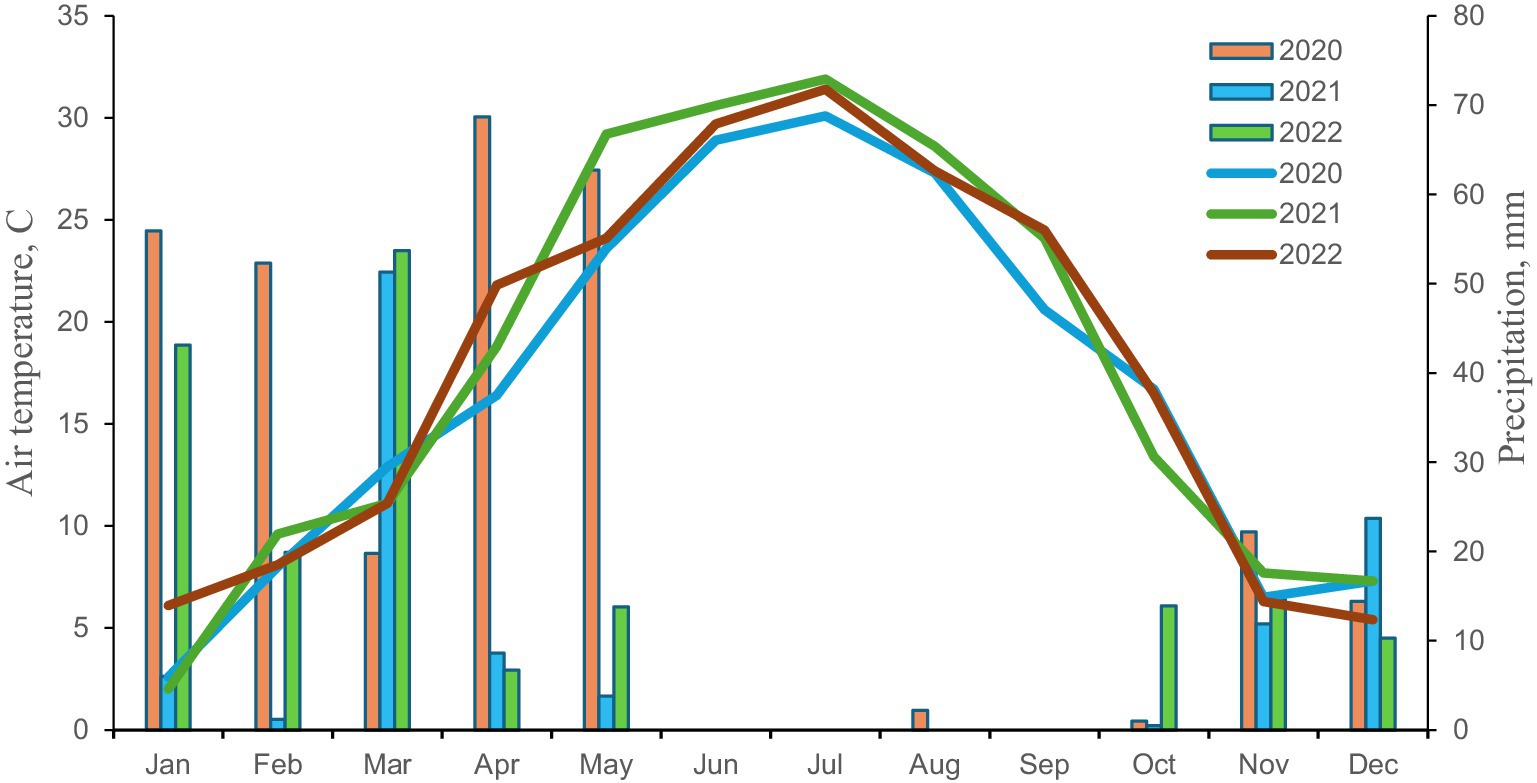
Figure 1. Air temperature (in curves) and precipitation data (in columns) were recorded in the study area, Tashkent region (2019–2022 years long-term data).
Typical sierosem soils in this region were not saline (2–4 dS m−1) and contained low levels of humus and nitrogen (N). The total amounts of phosphorus (P) and potassium (K) were 0.17 and 2.0%, respectively. In the 0–30 cm soil profile, the humus content was 1.29%, total N was 0.09, and total P was 0.14. Soil bulk density was 1.50 g/cm3 at the 0–30 cm soil profile. At the 30–50 cm soil depth, N-NO3 was 11.0–12.1 mg/kg, P2O5 was 14.5–16.8 mg/kg, and K2O was 210–220 mg/kg.
Experiment design
The experiment was conducted using a split-plot design with three replications in one block. The area of each plot was 240 m2 (50 m × 4.8 m), while the data-collecting area was 120 m2.
The main factor in the experiment was three chemical fertilization treatments at the following rates: N150P105K75, N180P125K90, and N210P145K105. The sub-plots included different combinations of foliar feeding with carbamide [CO(NH2)2] at the tillering, booting, and heading stages of WW, with doses of 4.0, 8.0, and 12.0 kg ha−1, respectively.
Three inorganic sources of N, P, and K were applied in the form of ammonium nitrate (34%), superphosphate (17%), and muriate of potash (52%). For this trial field, the applied doses of chemical fertilizers N, P (P2O5), and K (K2O) were divided into three sections. Ten days before planting, a basal dose comprising 100 kg ha−1 N (in the form of urea), 80 kg ha−1 P, and 60 kg ha−1 K was administered to a 15–20 cm deep soil layer. The two remaining portions were divided into equal parts and used as a band placement throughout the first and second irrigation cycles in spring at the booting and heading stages.
WW (cv. Grom) was planted at a rate of 200 kg ha−1 at the beginning of October. Furrow irrigation was applied three times at a norm of 700–800 m3 per hectare identically to all plots. Based on regional agronomic practices, all other agronomic activities, including plant protection, weeding, and other measures, were carried out uniformly in each plot.
Soil and plant chemical analysis
During the trial, soil samples were taken monthly from each replicated plot at a depth of 0 to 30 cm in sealable plastic bags. Following a two-week period of air drying at ambient temperature, the soil samples were pulverized and sieved using a 2-mm mesh screen before chemical analysis. Using a 1:5 ratio of soil to distilled water, the pH and EC characteristics of the soil were determined using an EC meter. The Tyurin method was used to determine organic materials, and the Lancaster method (NIAST, 2000) was used to assess available phosphate. The chemical composition of soil samples was examined using the accepted techniques established by Ryan et al. (2001). The standard core method was used to determine soil bulk density.
Plant samples that had been dried were pulverized and sieved using a 2-mm mesh to determine their chemical composition. One milliliter of concentrated sulfuric acid and 10 mL of 50% perchloric acid were poured into a tube containing 0.5 g of samples. The samples were then heated on a hot plate to decompose. Kjeldahl distillation, the vanadate method, and an inductively coupled plasma spectrophotometer were used to analyze total nitrogen, P2O, and K2O, respectively.
The grain of WW was analyzed in a 1 m2 area in each plot after harvesting the whole plots. The obtained values were recalculated after reaching the standard moisture (14%), and the 1,000-seed weight was determined. An Infratec™ Grain Analyzer 1,241 was used to ascertain grain protein and gluten content (%).
Statistical analysis
Using the CropStat 2.7. Statistical software program (2015), the collected data on grain and fodder yield, nutrient uptake, and grain quality parameters were subjected to a two-way analysis of the variance process (foliar feeding and chemical fertilization). The fixed predictor variables were the rates of chemical fertilizers. Unless otherwise specified, the main and interaction effects of predictor factors on dependent variables were considered significant at p ≤ 0.05.
Results and discussion
Grain yield
WW grain and fodder yield values significantly (p < 0.05) varied among soil NPK application, foliar treatment, and years, as well as their two- and three-way interactions reaching a significant level (Table 1). The effect of soil NPK application, foliar treatment, and their interactions was significant (p < 0.05) for grain quality indicators, such as 1,000-grain weight, protein content, and gluten content. However, the year effect and its interactions were not significant.

Table 1. Analysis of variance (F-values and significant levels) for grain yield, fodder yield, 1,000-grain weight, protein, and gluten contents of WW cultivated on NPK soil and foliar nutrition regimes.
Chemical fertilization in combination with foliar nutrition significantly enhanced the grain yield of WW with a statistically significant difference (Table 2). The main effect (chemical fertilization norms) was significant, exhibiting the effectiveness of chemical fertilization on the grain yield of WW. An increase in chemical fertilization norms consistently enhanced WW grain yield, whereas the highest grain production of WW was found at the moderate (N180P125K90) chemical fertilization norm in tandem with the 4:8:12 kg/ha foliar nutrition regime. In this treatment, the average grain yield was 26.7% higher compared to the same (N180P125K90) chemical fertilization treatment without any foliar feedings. Regardless of the foliar nutrition regimes, the lower chemical fertilization norm (N150P105K75) generated lower WW grain production compared to other treatments.
WW grain yield significantly increased with the treated foliar feeding norms. The greatest effect was observed at the 4:8:12 kg/ha foliar nutrition regime, exhibiting 14.9, 26.7, and 22.4%, respectively, under N210P145K105, N180P125K90, and N150P105K75 chemical fertilization norms compared to the respective control groups.
In the majority of cases, the application doses of the foliar feeding significantly affected WW grain yield. These results emphasized that foliar feeding used at the correct rate and time can enhance the efficiency of applied chemical fertilizers for WW production.
Similarly, the synergistic impact of chemical fertilization and foliar feeding had a significantly higher straw yield of WW (Table 3). The highest straw yield was observed when N180P125K90 chemical fertilizers were used in combination with the 4:8:12 kg/ha foliar nutrition regime, producing a 7.30 Mg ha−1 straw yield. This hit was followed by 7.25 and 7.21 Mg ha−1 straw yield generated under N210P145K105 fertilization × 0: 8: 12 kg/ha and N180P125K90 × 0.0: 8.0: 12.0 kg/ha foliar nutrition treatments, respectively.
Both grain and straw yields of WW decreased because of the application of the higher chemical fertilization norm (N210P145K105) in combination with the 4:8:12 kg/ha foliar nutrition regime, showing a toxic effect at high concentrations. When nutrients were sufficient, foliar feeding significantly increased crop yield in comparison to the control, indicating a positive link between N input and grain production. However, increased N applications in unfavorable circumstances may contribute to higher N loss in degraded soils because of denitrification (Afzal et al., 2015; Khaitov and Abdiev, 2018).
These results suggest that foliar feeding influences nutritional status and WW grain production by directly influencing vegetative and generative growth. In addition to chemical fertilization, foliar feeding, particularly in sufficient norms, has a major impact on WW growth and production (Bielashov et al., 2022). A sufficient amount of nutrients significantly increases the grain weight; on the other hand, an excessive supply of nutrients can have a detrimental effect on plant development, which stunts the plant’s growth and reduces its yield production (Fozia et al., 2018; Pandey et al., 2017).
Grain quality
In this study, the role of chemical fertilization in combination with foliar nutrition was similarly apparent, significantly enhancing WW grain quality indices (Table 4). Compared to the low chemical treatment (N150P105K75) without foliar nutrition, the tested parameters—1,000-grain weight, protein content, and gluten content—increased by 5.4, 3.9, and 0.4%, respectively, under the moderate chemical fertilization regime (N180P125K90), and by 6.03, 4.6, and 0.77%, respectively, under the high fertilization regime (N210P145K105). However, the effect of chemical fertilization on the grain quality parameters was more pronounced with foliar nutrition.
Despite the increased chemical fertilization, which significantly improved WW grain quality parameters, the highest values were found at the moderate (N180P125K90) fertilization combined with the 4:8:12 kg/ha foliar feeding regime, exhibiting significantly higher concentrations of protein (16.3%), gluten (26.3%), and 1,000-grain weight (39.8 g). When comparing the best treatment (N180P125K90 + 4:8:12 kg/ha foliar feeding) against the lowest one (N150P105K75 without foliar feeding), the grain quality parameters were 14.4, 5.9, and 3.1% higher for 1,000-grain weight, protein, and gluten, respectively.
The chemical fertilization × foliar feeding positively impacted nutrient concentration in the grain. The N, P, and K concentrations were significantly affected by chemical fertilization doses × foliar feeding regimes. The nutrient contents of WW grain increased with increasing chemical fertilization norms. Increased synthesis and availability of proteins and photosynthates, such as gluten, in the grain may have resulted from improved uptake of N and P, as well as other elements. This is the reason that these factors are critical to the yield and quality of WW grain. However, at the high chemical fertilization level, especially with foliar feeding, all grain quality parameters have fallen to a certain level, indicating a toxic point for plant life (Kakar et al., 2020; Khaitov, 2018).
N, P, and K concentrations in WW grains were significantly increased with an increase in chemical fertilization doses, regardless of foliar feeding (Table 5). Nevertheless, the pronounced effect of this combination was detected at the higher N210P145K100 fertilization in tandem with the 4:8:12 kg/ha foliar feeding regime, resulting in the highest N (2.320 mg/kg), P (0.920 mg/kg), and K (1.540 mg/kg) concentrations in the WW grains.
Means in each column followed by the same letters are not significantly different at p > 0.05.
Similarly, relatively higher nutrient uptake by WW was observed with the higher N210P145K100 fertilization combined with the 4:8:12 kg/ha foliar feeding regime. This combination resulted in the uptake of N (268.3 kg/ha), P (80.8 kg/ha), and K (196.1 kg/ha), followed by the N210P145K100 fertilization combined with the 4:8:12 kg/ha foliar feeding regime, which resulted in N (265.1 kg/ha), P (80.1 kg/ha), and K (192.1 kg/ha), respectively.
The higher nutrient uptake under the above-mentioned treatments was probably related to the intensive growth and development of crops and greater nutrient availability in the soil. The lower nutrient uptake was detected at the lowest chemical fertilization regime (N150P105K75) without foliar nutrition. Nutrient uptake increased with an increase in chemical fertilization doses and foliar feeding norms, accordingly. In agreement with previous studies, this finding elaborated a positive interaction between chemical fertilization and foliar nutrition on grain quality parameters when the right doses are applied (Nayak et al., 2024; Kumar et al., 2020). However, the highest parameters were achieved with moderate chemical fertilization, while the efficiency of these fertilizers depends mostly on foliar nutrition.
Nutrient use efficiency
Table 6 shows a synergistic effect of chemical fertilization and foliar feeding on generating 1 Mg of WW grain. Higher chemical fertilization doses decreased the amount of N, P, and K for this indicator, regardless of the foliar feeding application.
In recent years, several models related to the accumulation, distribution, and remobilization of nutrients in plants’ aboveground and belowground parts have been created and used (Raun et al., 2019).
As shown in Table 7, the highest N value (46.3 kg) was shown with the N210P145K100 treatment without foliar feeding, whereas the 4:8:12 kg/ha foliar application with the same rate of N treatment decreased N amount by 8.4%. Similarly, the highest P (13.5 kg) and K (31.4 kg) values were found under the high chemical fertilization norm (N210P145K100) with the 4:0:12 kg/ha foliar feeding regime.
This pattern was also evident in the overall output of WW, indicating that the use of chemical fertilizers significantly enhanced WW yield and that foliar feeding improved its efficacy.
Although the plants’ primary entry point is their roots, the form, transport, and availability of water; root architecture and distribution; plant species; and soil compaction all affect how nutrients are absorbed and accumulated in the grains (Tadayon and Hosseini, 2022). In the case of foliar nutrition, nutrients get access to the leaf before going via a leaf cell’s cytoplasm, thereby increasing the efficacy of plant nutrition.
Crop productivity can be improved with early foliar treatments by encouraging more vigorous growth or optimizing the yield potential (Afshari et al., 2022). The effects of enhanced nutrient complexation with the amine group present in the substrate utilized for foliar nutrition led to improved absorption and accumulation of nutrients in grains during foliar feeding (Świerczyński et al., 2022). Plants typically absorb nutrients from the soil through their roots; however, a number of variables, including soil pH, moisture content, and compaction, are anticipated to impact how well the roots absorb nutrients (Bloch et al., 2020).
According to reports, macronutrients (N, P, and K) have an impact on the growth and development of plants since they are engaged in several metabolic processes, such as photosynthesis and respiration (Cho et al., 2023). The enhanced uptake of nutrients from the soil by roots is indirectly related to these activities.
The applied treatments had no significant effect on soil quality parameters (humus, N, P, and K concentrations), regardless of the applied combinations in both 0–30 and 30–50 cm soil profiles (Table 8). The provision of additional macroelements to plants via foliar feeding, up to an upper limit, may have facilitated a decrease in nutrient uptake from the soil (Brar et al., 2015; Nikiforov et al., 2019). It was anticipated that increasing nutrient uptake through foliar seeding would reduce the amount of chemical fertilizers used in irrigated WW production (Patel et al., 2022; Jahangir et al., 2024). In arid agroecosystems, reducing the doses of applied inorganic fertilizers in this experiment is an essential step to developing sustainable soil management systems.
In addition to enhancing nutritional balance and lowering the need for chemical fertilizers, foliar feeding as supplemental nutrition can minimize land degradation, conserve biodiversity, increase crop yield, and contribute to global food security.
The foliar nutrition strategy synergistically enhanced nutrient availability to sustain profitable WW production under continental climatic conditions, as indicated by a considerably higher NUE attained at the N180P125K90 × 4:8:12 kg/ha foliar application. It further increase to N210P145K105 kg/ha did not provide a beneficial effect in WW vegetative and generative parameters.
Figure 2 shows a positive correlation between increased WW yield and increased chemical fertilization doses; nevertheless, foliar nutrition exerted additive effects when applied on the right date and doses (4:8:12 kg/ha). The difference in Pearson’s coefficient between the treatment of chemical fertilization (N180P125K90) coupled with foliar feeding (4:8:12 kg/ha) was higher (R2 = 0.8844) than the difference in the treatment of chemical fertilization (N210P145K105) associated with foliar nutrition (R2 = 0.6981). There was also a positive correlation at the lower chemical fertilization doses (N150P105K75) correlated with foliar feeding with a Pearson’s coefficient value of R2 = 0.7356.
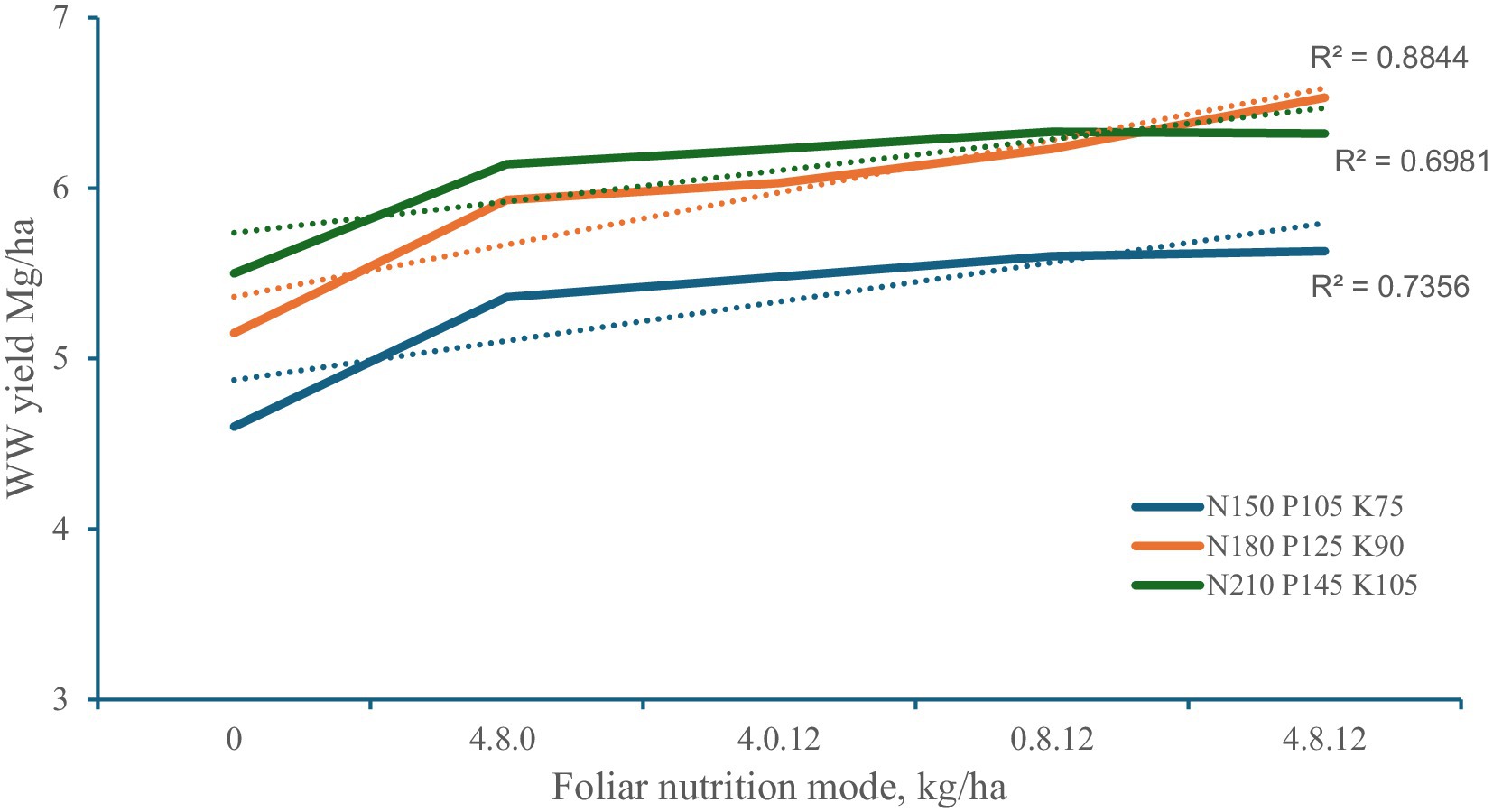
Figure 2. Correlation between chemical fertilization doses and foliar nutrition modes averaged over the study years.
This study clearly demonstrates that higher rates of chemical fertilizers are not always profitable. In contrast, the judicious use of fertilizers combined with foliar feeding can enhance both high yield and nutrient use efficiency. This finding is consistent with the study by Singh et al. (2021), who emphasized this approach as a key pathway for scaling up nutrient management options, including foliar nutrition, which should be widely adopted for crop production, especially in degraded soils (Lovreškov et al., 2022; Shareef et al., 2021). Avoiding and minimizing soil degradation and repairing degraded land through these non-conventional soil stabilization techniques are crucial in the fight against desertification (Kaur et al., 2020; Raun et al., 2019). While integrating multiple tools, this strategy minimizes nitrogen loss, improves nitrogen usage efficiency, maximizes crop output, and limits negative anthropogenic impacts on the environment (Khaitov et al., 2024a,b).
Judicious use of chemical fertilizers in conjunction with foliar nutrition should be studied further to produce the notable yield-boosting effects of WW as seen in this study. However, future studies should focus on the optimal rate of necessary microelements and nanonutrition while taking into account the financial and environmental advantages of growing WW in arid regions.
Conclusion
This study revealed that the synergistic effect of chemical fertilization and foliar nutrition doses was more pronounced at the N180P125K90 × 4:8:12 kg/ha interactions, reaching the highest WW grain yield (7.3 Mg ha−1) among other variables. Similarly, the effect of foliar feeding exerted additive effects with the 4:8:12 kg/ha regime on protein, gluten, and 1,000-grain weight of WW in combination with the moderate (N180P125K90) chemical fertilization norm. In addition, N, P, and K concentrations in WW grain were affected by the N180P125K90 × 4:0:12 kg/ha treatment interactions.
Taken together, foliar nutrition is an essential technique for enhancing the efficiency of applied chemical fertilizers in WW production. As this study showed, it is important to use the optimum rate of fertilization and innovative application techniques to improve plant growth, boost WW productivity, and mitigate climate-related risks while rehabilitating agroecosystem services in arid lands.
Data availability statement
The raw data supporting the conclusions of this article will be made available by the authors, without undue reservation.
Author contributions
KS: Writing – original draft, Writing – review & editing, Investigation. GK: Writing – original draft, Writing – review & editing, Methodology. JE: Writing – original draft, Writing – review & editing, Data curation. KA: Writing – original draft, Writing – review & editing, Formal analysis, Methodology. OS: Writing – original draft, Writing – review & editing, Investigation, Resources. KK: Writing – original draft, Writing – review & editing, Data curation, Formal analysis. JK: Writing – original draft, Writing – review & editing, Investigation, Methodology. SS: Investigation, Writing – original draft, Writing – review & editing, Project administration. SI: Writing – original draft, Writing – review & editing, Conceptualization, Formal analysis. AD: Writing – original draft, Writing – review & editing, Methodology. RI: Methodology, Writing – original draft, Writing – review & editing, Validation. NJ: Validation, Writing – original draft, Writing – review & editing. MK: Writing – original draft, Writing – review & editing, Conceptualization, Visualization. LK: Writing – original draft, Writing – review & editing, Investigation, Methodology. NY: Formal analysis, Software, Writing – original draft, Writing – review & editing. ND: Conceptualization, Validation, Writing - original draft, Writing - review & editing. RY: Data curation, Formal analysis, Validation, Writing – original draft, Writing – review & editing. BK: Conceptualization, Writing – original draft, Writing – review & editing.
Funding
The author(s) declare that no financial support was received for the research, authorship, and/or publication of this article.
Conflict of interest
The authors declare that the research was conducted in the absence of any commercial or financial relationships that could be construed as a potential conflict of interest.
Generative AI statement
The authors declare that no Gen AI was used in the creation of this manuscript.
Publisher’s note
All claims expressed in this article are solely those of the authors and do not necessarily represent those of their affiliated organizations, or those of the publisher, the editors and the reviewers. Any product that may be evaluated in this article, or claim that may be made by its manufacturer, is not guaranteed or endorsed by the publisher.
References
Afshari, F., Nakhaei, F., Mosavi, S., and Seghatoleslami, M. (2022). Physiological and biochemical responses of Stevia rebaudiana Bertoni to nutri-priming and foliar nutrition under water supply restrictions. Ind. Crop. Prod. 176:114399. doi: 10.1016/j.indcrop.2021.114399
Afzal, I., Hussain, B., Maqsood, S., Basra, A., Shakeel, Q., and Kamran, M. (2015). Foliar application of potassium improves fruit quality and yield of tomato plants. Acta Sci. Pol. 14, 3–13. Available at: https://www.acta.media.pl/pl/full/7/2015/000070201500014000010000300013.pdf
Amoakwah, E., Kim, S. H., Jeon, S., Shim, J. H., Lee, Y. H., Kwon, S. I., et al. (2024). Long-term fertilization and liming increase soil fertility but reduce carbon stratification and stocks of paddy rice soils. Front. Soil Sci. 4:1426894. doi: 10.3389/fsoil.2024.1426894
Arifur Rahman, M., Harker, T., Lewis, W., and Islam, K. R. (2024). Chelated-and nano iron fertilization affects nutrient uptake and translocation in fresh market tomatoes. J. Plant Nutr. 47, 1152–1174. doi: 10.1080/01904167.2024.2304166
Behnassi, M., Baig, M. B., Sraïri, M. T., Alsheikh, A. A., and Abu Risheh, A. W. A. (2022). Food security and climate-smart food systems. US: Springer International Publishing.
Bielashov, O., Rozhkov, A., Kalenska, S., Karpuk, L., Marenych, M., Kuts, O., et al. (2022). Influence of pre-sowing application of mineral fertilizers, root and foliar nutrition on productivity of winter triticale plants. Ecol. Eng. Environ. Tech. 23, 1–4. doi: 10.12912/27197050/152118
Bloch, S. E., Ryu, M. H., Ozaydin, B., and Broglie, R. (2020). Harnessing atmospheric nitrogen for cereal crop production. Curr. Opin. Biotechnol. 62, 181–188. doi: 10.1016/j.copbio.2019.09.024
Brar, B. S., Singh, J., Singh, G., and Kaur, G. (2015). Effects of long term application of inorganic and organic fertilizers on soil organic carbon and physical properties in maize–wheat rotation. Agronomie 5, 220–238. doi: 10.3390/agronomy5020220
Cho, W., Lambert, D. M., Brorsen, B. W., Maples, C. H., Fornah, A., and Raun, W. R. (2023). A Bayesian approach for analyzing crop yield response data with limited treatments. Agrosyst, Geosci. Environ. 6:e20358. doi: 10.1002/agg2.20358
CropStat 2.7. Statistical software program. (2015). International Rice research institute, Philippines. Available at: www.bbi.irri.org/products (Accessed March 21, 2024).
De Rosa, D., Basso, B., Fasiolo, M., Friedl, J., Fulkerson, B., Grace, P. R., et al. (2021). Predicting pasture biomass using a statistical model and machine learning algorithm implemented with remotely sensed imagery. Comput. Electron. Agric. 180:105880. doi: 10.1016/j.compag.2020.105880
FAO (FAOSTAT). (2024). Food and agriculture Organization of the United Nations. Rome Available at: http://faostat.fao.org, 403–403. (Accessed September 14, 2024).
Fozia, J. M., Zahid, A., Khan, A. A., Sai-Jun, C., and Ramzan, M. (2018). Vegetative and reproductive response of bitter gourd to the foliar application of boric acid. Sci. Lett. 6, 88–93. Available at: https://thesciencepublishers.com/science_letters/files/v6i3-1-132018013-SL.pdf
Iqbal, M. A., Abdul, H., Muzammil, H. S., Imtiaz, H., Tanveer, A., Saira, I., et al. (2019). A meta-analysis of the impact of foliar feeding of micronutrients on productivity and revenue generation of forage crops. Planta Daninha 37:e019189237. doi: 10.1590/s0100-83582019370100046
Ishfaq, M., Kiran, A., Ur Rehman, H., Farooq, M., Ijaz, N. H., Nadeem, F., et al. (2022). Foliar nutrition: potential and challenges under multifaceted agriculture. Environ. Exp. Bot. 200:104909. doi: 10.1016/j.envexpbot.2022.104909
Jahangir, M. M. R., Kamruzzaman, M., Ferdous, J., Rahman, M. S., and Islam, K. R. (2024). Integrating nitrogen fertilization with crop residues to improve nitrogen management in intensively managed cropping systems. Arch. Agron. Soil Sci. 70, 1–16. doi: 10.1080/03650340.2023.2283191
Kakar, K., Xuan, T. D., Noori, Z., Aryan, S., and Gulab, G. (2020). Effects of organic and inorganic fertilizer application on growth, yield, and grain quality of rice. Agriculture 10:544. doi: 10.3390/agriculture10110544
Kaur, H., Nelson, K. A., Wikle, C. K., Ferguson, R., and Singh, G. (2024). Nitrogen fertilizer and pronitridine rates for corn production in the Midwest US. Field Crop Res. 306:109200. doi: 10.1016/j.fcr.2023.109200
Kaur, G., Singh, G., Motavalli, P. P., Nelson, K. A., Orlowski, J. M., and Golden, B. R. (2020). Impacts and management strategies for crop production in waterlogged or flooded soils: a review. Agron. J. 112, 1475–1501. doi: 10.1002/agj2.20093
Khaitov, B. (2018). Effects of Rhizobium inoculation and magnesium application on growth and nodulation of soybean (Glycine max L.). J. Plant Nutr. 41, 2057–2068. doi: 10.1080/01904167.2018.1485164
Khaitov, B., and Abdiev, A. (2018). Performance of chickpea (Cicer arietinum L.) to bio-fertilizer and nitrogen application in arid condition. J. Plant Nutr. 41, 1980–1987. doi: 10.1080/01904167.2018.1484134
Khaitov, B., Abdualimov, S., Allanov, K., Khalikov, B., Avliyakulov, M., Islamov, S., et al. (2024a). The efficiency of silicious nano nutrition on cotton productivity in arid regions. Front. Sustain. Food Systems 8:1362369. doi: 10.3389/fsufs.2024.1362369
Khaitov, B., Allanov, K., Islam, K. R., and Park, K. W. (2019). Bio-inoculant improves nitrogen-use efficiency and cotton yield in saline soils. J. Plant Nutr. Soil Sci. 182, 393–400. doi: 10.1002/jpln.201800063
Khaitov, B., Tadjetdinov, N., Sayimbetov, A., Khaitbaeva, J., Sindarov, O., Khakberdiev, O., et al. (2024b). Improving the growth of Glycyrrhiza Glabra L. in saline soils using bioagent seed treatments. Eur. J. Soil Sci. 13, 43–51. doi: 10.18393/ejss.1390588
Kumar, Y. S., Hemalatha, S., Chandrika, V., Latha, P., and Sagar, G. K. (2020). Growth and yield of summer blackgram (Vigna mungo L.) as influenced by moisture stress and foliar nutrition. Andhra Pradesh J. Agril. Sci. 6, 111–114.
Lovreškov, L., Radojčić Redovniković, I., Limić, I., Potočić, N., Seletković, I., Marušić, M., et al. (2022). Are foliar nutrition status and indicators of oxidative stress associated with tree defoliation of four Mediterranean Forest species? Plan. Theory 11:3484. doi: 10.3390/plants11243484
Nayak, S., Tarai, R. K., Swain, S. C., Samal, S., Pradhan, S., Sethy, B. K., et al. (2024). Effect of foliar feeding with nutrients and bioregulators on yield and quality attributes of Litchi cv. Bombai. Horticult. 10:188. doi: 10.3390/horticulturae10020188
NIAST (2000). Method of soil and plant analysis; National Institute of agricultural science and technology. Suwon, Republic of Korea: NIAST.
Nikiforov, V. M., Nikiforov, M. I., Silaev, A. A., Chekin, G. V., Smolsky, E. V., Nechaev, M. M., et al. (2019). The use of microelement chelates in the technology of winter triticale cultivation. Bulletin of the Bryansk State Agricultural Academy 5, 28–34.
Nurbekov, A., Kosimov, M., Shaumarov, M., Khaitov, B., Qodirova, D., Mardonov, H., et al. (2023). Short crop rotation under no-till improves crop productivity and soil quality in salt affected areas. Agronomie 13:2974. doi: 10.3390/agronomy13122974
Pandey, R. V., Singh, R., Singh, N., and Kumar, Y. (2017). Effect of foliar application of nitrogen on growth and yield of vegetable pea (Pisum sativum L.) cv. Kashi Udai. Int. J Pharmacogn. Phytochem 6, 1500–1502. Available at: https://www.phytojournal.com/archives/2017/vol6issue5/PartV/6-4-307-865.pdf
Patel, J. J., Mangroliya, R. M., and Patel, N. A. (2022). Role of micronutrients foliar nutrition in vegetable production: a review. J. Exp. Agric. Int. 44, 159–168. doi: 10.9734/jeai/2022/v44i112062
Paul, M. Jr., Salama, Y., Abay, K. A., Abdelaziz, F., Zaccari, C., Akramkhanov, A., et al. (2024). Harnessing digital innovations for climate action and market access: opportunities and constraints in the CWANA region. Glob. Food Secur. 1:100763. doi: 10.1016/j.gfs.2024.100763
Raun, W. R., Dhillon, J., Aula, L., Eickhoff, E., Weymeyer, G., Figueirdeo, B., et al. (2019). Unpredictable nature of environment on nitrogen supply and demand. Agron. J. 111, 2786–2791. doi: 10.2134/agronj2019.04.0291
Rout, G. R., and Sahoo, S. (2015). Role of iron in plant growth and metabolism. Rev. Agric. Sci. 3, 1–24. doi: 10.7831/ras.3.1
Ryan, J., Estefan, G., and Rashid, A. (2001). Soil and plant analysis laboratory manual. 2nd Edn. Allepo, Syria: International Center for Agricultural Research in the Dry Areas (ICARDA).
Shareef, H. J., Al-Tememi, I. H., and Abdi, G. (2021). Foliar nutrition of date palm: advances and applications. A review. Folia oecologica 48, 82–99. doi: 10.2478/foecol-2021-0010
Singh, P., Sammauria, R., Singh, S., Meena, O. P., Sharma, S., Gupta, S., et al. (2021). Effect of foliar nutrition of water soluble fertilizers on crop growth, yield and economics of mustard under semi-arid conditions. Indian Res. J. Ext. Edu 21, 144–149. doi: 10.18805/IJARe.A-5635
Świerczyński, S., Zydlik, Z., and Kleiber, T. (2022). The influence of foliar nutrition of apple trees with silicon on growth and yield as well as mineral content in leaves and fruits. Agronomie 12:1680. doi: 10.3390/agronomy12071680
Keywords: arid lands, chemical fertilization, foliar nutrition, grain yield, soil fertility, winter wheat production
Citation: Sultonov K, Kholmurodova G, Eshonkulov J, Allanov K, Sindarov O, Khayitov K, Khaitbaeva J, Salomov S, Isaev S, Djumanazarova A, Imyaminova R, Jurayeva N, Karimova M, Khayrullaeva L, Yakubjonova N, Durdiev N, Yuldasheva R and Khaitov B (2025) Effect of integrative NPK soil and foliar nutrition on winter wheat (Triticum aestivum L.) productivity in irrigated arid lands. Front. Sustain. Food Syst. 8:1508913. doi: 10.3389/fsufs.2024.1508913
Edited by:
Francesco Montemurro, Council for Agricultural Research and Agricultural Economy Analysis | CREA, ItalyReviewed by:
Victor Kavvadias, Hellenic Agricultural Organization – ELGO, GreeceCosmas Wacal, Mountains of the Moon University, Uganda
Copyright © 2025 Sultonov, Kholmurodova, Eshonkulov, Allanov, Sindarov, Khayitov, Khaitbaeva, Salomov, Isaev, Djumanazarova, Imyaminova, Jurayeva, Karimova, Khayrullaeva, Yakubjonova, Durdiev, Yuldasheva and Khaitov. This is an open-access article distributed under the terms of the Creative Commons Attribution License (CC BY). The use, distribution or reproduction in other forums is permitted, provided the original author(s) and the copyright owner(s) are credited and that the original publication in this journal is cited, in accordance with accepted academic practice. No use, distribution or reproduction is permitted which does not comply with these terms.
*Correspondence: Botir Khaitov, YmhhaXRvdkB5YWhvby5jb20=
 Komolitdin Sultonov1
Komolitdin Sultonov1 Kholmurod Khayitov
Kholmurod Khayitov Botir Khaitov
Botir Khaitov